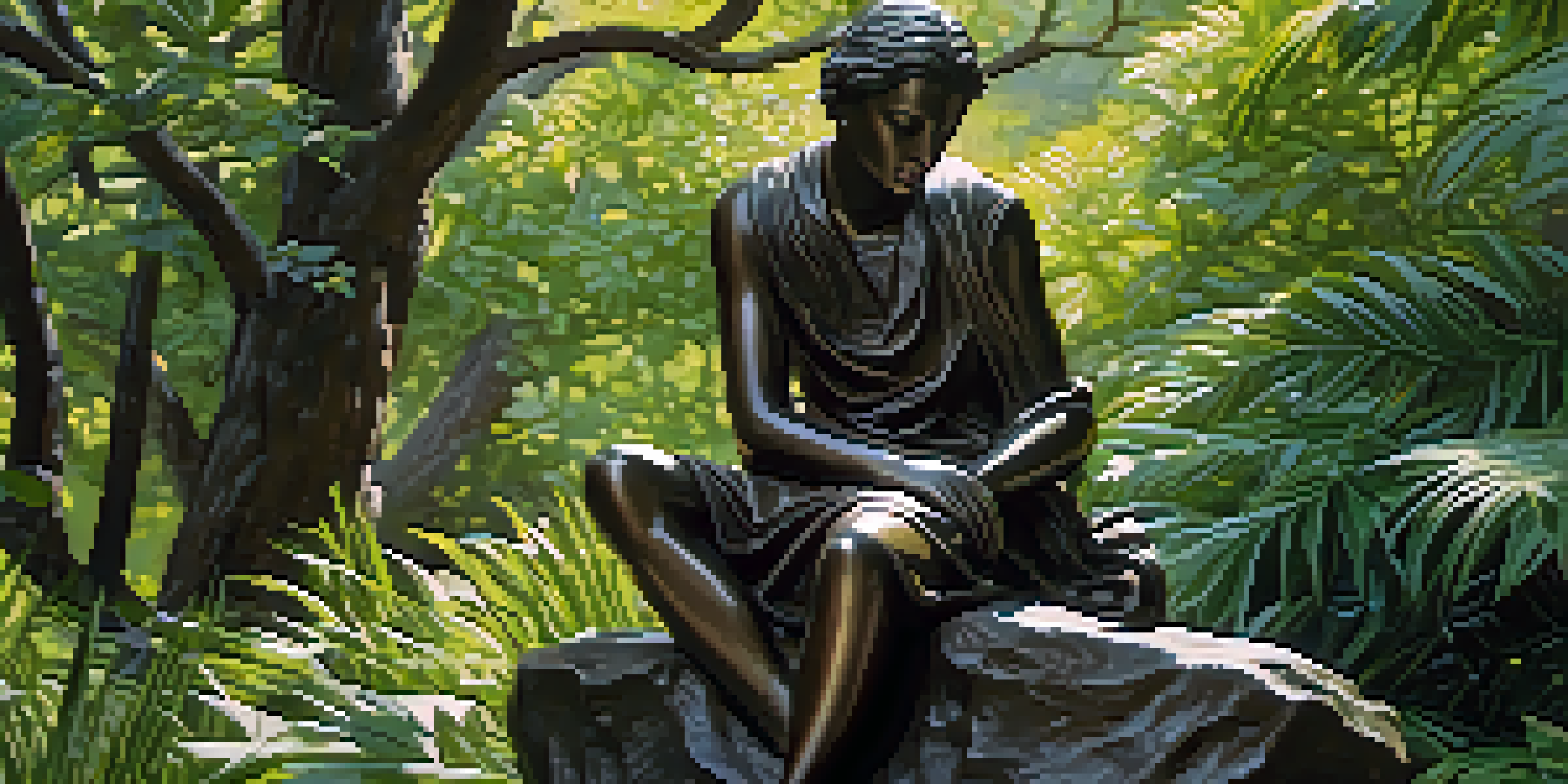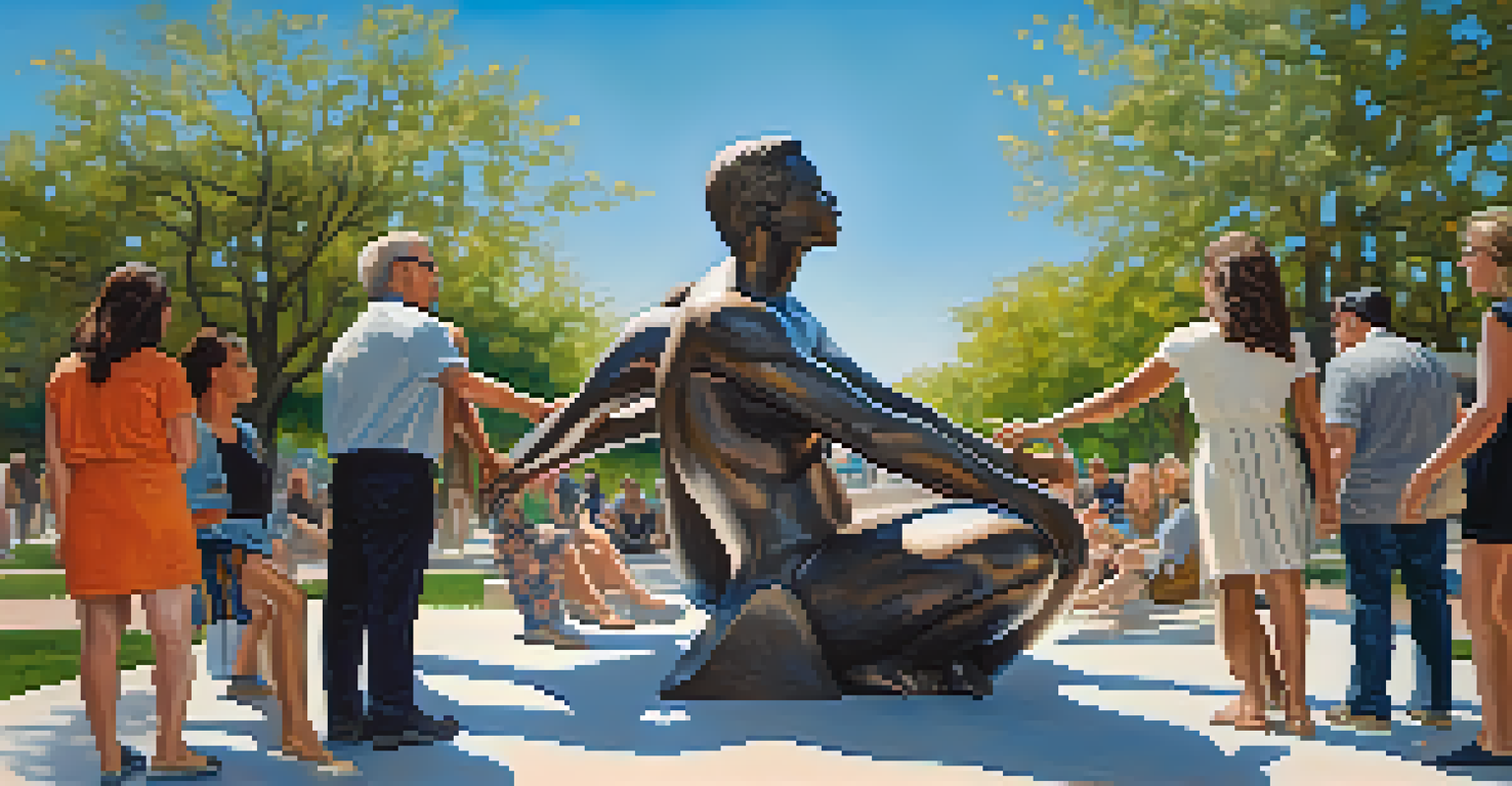Sculpture as a Medium for Social Justice Awareness

Understanding Sculpture as a Form of Expression
Sculpture, often perceived as simply an art form, holds deeper meanings and serves as a powerful medium for expression. Artists can convey complex emotions and societal issues through tangible forms, making abstract concepts more relatable. Just as a storyteller uses words, sculptors use materials to communicate their messages, often reflecting the realities of the human experience.
Art is not freedom from discipline, but disciplined freedom.
For instance, consider the iconic 'The Thinker' by Auguste Rodin, which inspires contemplation about existence and purpose. Similarly, modern sculptures can provoke thought about pressing social issues, encouraging viewers to engage with the topic on a personal level. This connection between the viewer and the artwork can be a catalyst for change, sparking discussions about social injustices.
Through its three-dimensional presence, sculpture invites audiences to walk around and explore perspectives, much like navigating through life’s challenges. This immersive quality makes it a unique tool for raising awareness, as it encourages interaction and introspection, prompting individuals to reflect on their own beliefs and actions.
Historical Context: Sculptures that Sparked Change
Throughout history, sculptures have played significant roles in social movements, serving as symbols of resistance and hope. For example, the Statue of Liberty has long represented freedom and democracy, inspiring countless individuals to pursue better lives. Similarly, sculptures like the 'Tear Drop' Memorial, which honors victims of terrorism, provoke important conversations about violence and the need for peace.

In more recent times, the 'Fearless Girl' statue faced Wall Street, challenging gender inequality in the corporate world. This piece of art quickly became a symbol of empowerment, encouraging women to stand strong against societal norms. Such examples highlight how sculptures can capture the spirit of a movement and galvanize public support for social justice causes.
Sculpture as Emotional Expression
Sculptures serve as a powerful medium for artists to convey complex emotions and societal issues, fostering personal connections with viewers.
These historical sculptures not only commemorate struggles and triumphs but also remind us of our shared responsibilities. They serve as visual reminders that art can transcend language barriers, reaching audiences worldwide and fostering a sense of solidarity among diverse groups.
Contemporary Artists Using Sculpture for Advocacy
Today, contemporary artists continue to harness the power of sculpture to address various social justice issues. Artists like Ai Weiwei utilize his work to highlight human rights abuses, often creating provocative installations that draw attention to global crises. His piece, 'Sunflower Seeds,' encourages viewers to consider the implications of mass production and consumerism on society.
The artist is not a special kind of person; rather each person is a special kind of artist.
Another example is the work of Hank Willis Thomas, who addresses race and identity through his thought-provoking sculptures. His installations often challenge viewers to confront uncomfortable truths about societal perceptions and biases, fostering dialogue around these critical topics. Through their art, these creators inspire audiences to reflect on their values and the world around them.
By leveraging their craft, contemporary sculptors are able to engage with pressing social issues in ways that resonate with today's audiences. Their innovative approaches not only elevate the conversation but also demonstrate that art can be a powerful agent for change.
Sculpture in Public Spaces: Engaging Communities
Public sculptures play a vital role in fostering community engagement and awareness around social justice. These installations often serve as focal points for local discussions, encouraging residents to come together and reflect on shared values. For instance, the 'Freedom' sculpture in Washington D.C. sparks conversations on civil rights and the ongoing struggle for equality.
Moreover, public art can inspire activism by providing a platform for underrepresented voices. Sculptures that reflect the diversity and history of a community can empower individuals, reminding them of their collective strength and resilience. For example, the 'Martin Luther King Jr. Memorial' serves as a reminder of the fight for justice and equality, inspiring new generations to continue the work.
Historical Impact on Social Movements
Throughout history, sculptures have symbolized resistance and hope, playing crucial roles in galvanizing public support for social justice causes.
The presence of art in public spaces can also elevate social issues, making them accessible to a wider audience. When people encounter sculptures that resonate with their experiences, it encourages them to engage with the subject matter, fostering a sense of shared responsibility and action toward social change.
Sculpture as a Tool for Education and Awareness
Sculpture can serve as an educational tool, raising awareness about social justice issues in schools and communities. By incorporating art into educational curricula, educators can teach students about history, culture, and the importance of advocacy. For example, students can study sculptures that address environmental issues, prompting discussions on sustainability and responsibility.
Workshops and community projects involving sculpture can also help individuals explore their thoughts and feelings about social issues. By creating their own artworks, participants can express their perspectives and connect with others who share similar experiences. These collaborative efforts often lead to increased empathy and understanding within the community.
Furthermore, sculptures can act as conversation starters, inviting people to engage in dialogue about important topics. When art is used as a medium for education, it not only enhances learning but also empowers individuals to become advocates for change in their own communities.
The Emotional Impact of Sculptures on Social Issues
One of the most profound aspects of sculpture as a medium is its ability to evoke emotions and provoke thought. When viewers encounter a sculpture that resonates with them, it can trigger strong feelings, from empathy to outrage. This emotional connection can inspire individuals to take action and engage with social justice causes, as they feel compelled to respond to the issues portrayed in the artwork.
For example, the 'Memorial to Victims of the Holocaust' in Berlin serves as a powerful reminder of the atrocities committed during World War II. The sheer scale and somber design evoke feelings of loss and reflection, prompting visitors to confront the past and consider the importance of tolerance and acceptance in contemporary society.
Sculpture in Community Engagement
Public sculptures encourage community dialogue and activism, reflecting shared values and inspiring collective action toward social change.
By tapping into our emotions, sculptures can bridge the gap between art and activism, encouraging people to reflect on their roles in addressing social injustices. This emotional resonance makes sculpture a unique and impactful medium for raising awareness and fostering change.
The Future of Sculpture in Social Justice Movements
As social justice movements continue to evolve, the role of sculpture in advocating for change will remain significant. With advancements in technology and new materials, artists are finding innovative ways to express their messages. For instance, digital sculptures and augmented reality installations are beginning to emerge, allowing for dynamic interactions with audiences and expanding the reach of social justice narratives.
Moreover, as more artists from diverse backgrounds gain recognition, we can expect a broader array of perspectives and experiences to be represented in sculptures. This diversity will enrich the dialogue surrounding social justice issues, inviting more people to engage with the art and the causes it represents.

Ultimately, the future of sculpture in social justice movements lies in its ability to adapt and resonate with new generations. Through creativity and collaboration, sculpture will continue to be a vital tool for raising awareness, inspiring action, and fostering meaningful conversations around the pressing social issues of our time.